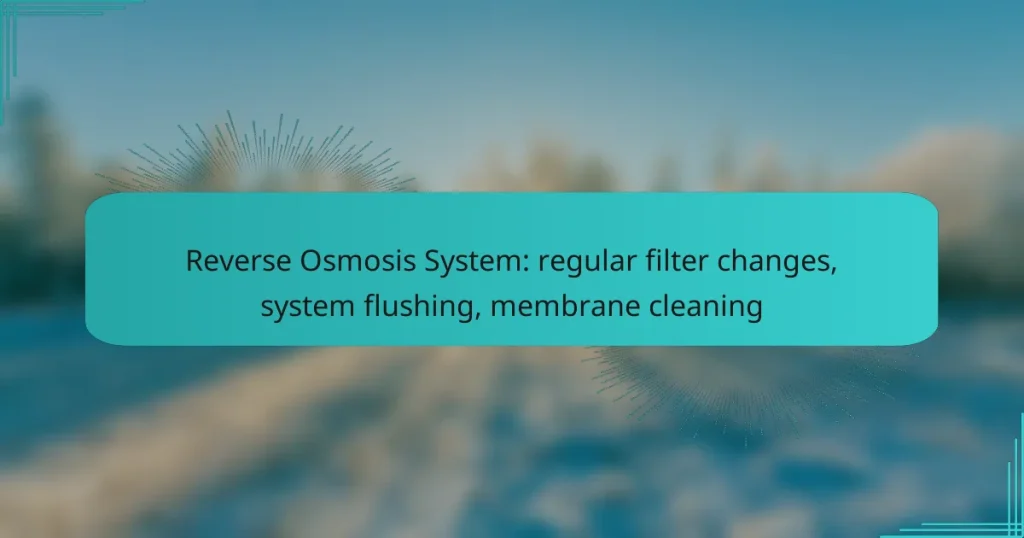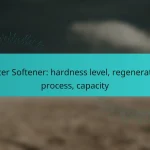A reverse osmosis system requires regular maintenance to ensure the production of clean and safe drinking water. This includes changing filters every 6 to 12 months, flushing the system to remove contaminants, and cleaning the membranes to prevent fouling. By adhering to these practices, you can maintain optimal performance and extend the lifespan of your system.
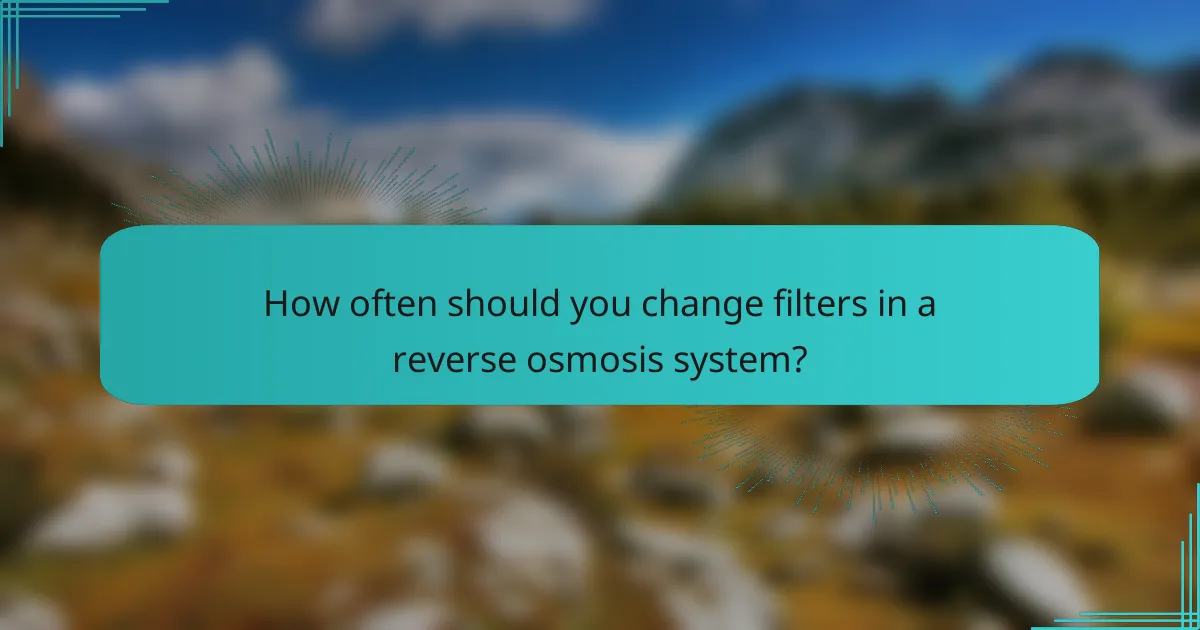
How often should you change filters in a reverse osmosis system?
Filters in a reverse osmosis system should typically be changed every 6 to 12 months, depending on usage and water quality. Regular changes help maintain optimal performance and ensure clean drinking water.
Every 6 to 12 months
Changing filters every 6 to 12 months is a common guideline for reverse osmosis systems. This timeframe helps prevent clogging and maintains the efficiency of the filtration process. If your system is used heavily or if you notice a decrease in water quality, consider changing the filters closer to the 6-month mark.
Regular filter changes can also extend the lifespan of the reverse osmosis membrane, which is more expensive to replace. Keeping to this schedule ensures that your system operates effectively and provides safe drinking water.
Depends on water quality
The frequency of filter changes can vary significantly based on the quality of your source water. If your water contains high levels of sediment, chlorine, or other contaminants, you may need to replace filters more frequently. Conversely, if your water is relatively clean, you might extend the interval between changes.
Testing your water quality periodically can help you determine the right schedule for filter changes. For example, if you notice changes in taste, odor, or color, it may be time to check and replace your filters.
Manufacturer recommendations
Always consult the manufacturer’s guidelines for your specific reverse osmosis system, as they provide tailored recommendations based on the design and components of the unit. These guidelines often include specific timelines for filter and membrane replacements.
Following the manufacturer’s recommendations helps ensure that your system operates within its intended parameters, maximizing efficiency and water quality. If you have lost the manual, many manufacturers provide this information online, making it easy to access.
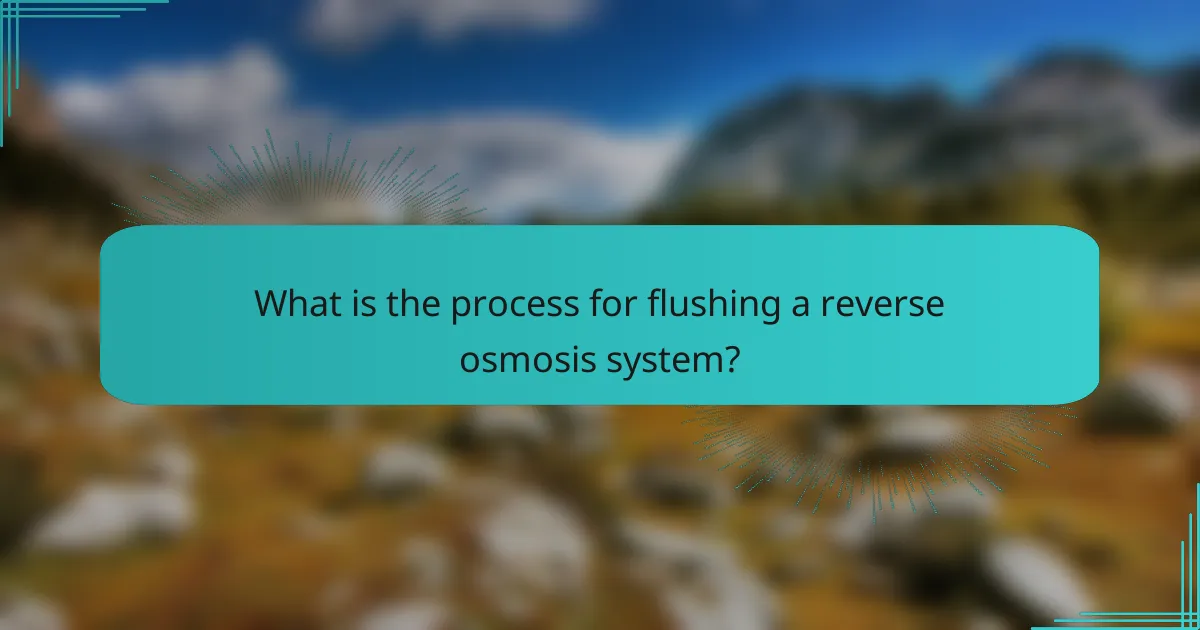
What is the process for flushing a reverse osmosis system?
Flushing a reverse osmosis system involves running water through the system to remove accumulated contaminants and maintain optimal performance. This process helps to ensure that the water produced remains clean and safe for consumption.
Initial preparation steps
Before flushing your reverse osmosis system, turn off the water supply and disconnect the system from the power source. Gather necessary tools and materials, including a clean bucket to collect the flushed water. It’s also advisable to check the manufacturer’s guidelines for any specific instructions related to your model.
Next, ensure that the storage tank is empty. Open the faucet to release any remaining water, which will help facilitate the flushing process. This step is crucial for effectively clearing out contaminants.
Flushing frequency guidelines
Flushing your reverse osmosis system should generally be done every six months to a year, depending on water quality and usage. If you notice a decrease in water pressure or taste, consider flushing more frequently. Regular flushing helps to prolong the life of the membrane and improve overall system efficiency.
In areas with high sediment or chlorine levels, more frequent flushing may be necessary. Monitoring the system’s performance can help determine the best flushing schedule for your specific situation.
Tools needed for flushing
The primary tools needed for flushing a reverse osmosis system include a clean bucket, a wrench for disconnecting fittings, and a hose for directing water flow. You may also want to have a timer handy to track flushing duration, which typically lasts around 10 to 15 minutes.
Additionally, having replacement filters on hand is advisable, as flushing can sometimes reveal the need for filter changes. Always refer to your system’s manual for any specific tools or materials recommended for flushing.
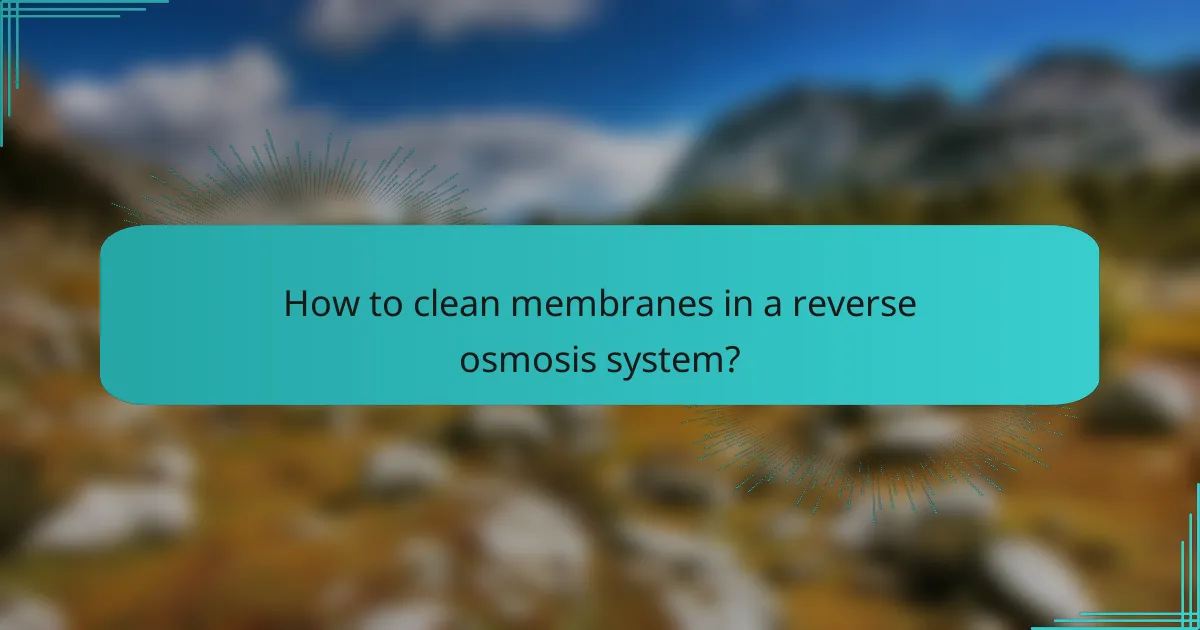
How to clean membranes in a reverse osmosis system?
Cleaning membranes in a reverse osmosis system involves using specific agents and techniques to restore their efficiency. Regular maintenance helps prevent fouling and extends the lifespan of the membranes.
Cleaning agents to use
Common cleaning agents for reverse osmosis membranes include citric acid, sodium hydroxide, and proprietary cleaning solutions designed for membrane systems. Citric acid is effective for removing mineral scale, while sodium hydroxide can help eliminate organic fouling. Always follow the manufacturer’s recommendations for the appropriate cleaning agent and concentration.
It’s crucial to avoid harsh chemicals that can damage the membrane material. For example, bleach and other chlorine-based cleaners should be strictly avoided, as they can degrade the membrane’s structure.
Frequency of membrane cleaning
The frequency of membrane cleaning depends on water quality and usage patterns. Generally, membranes should be cleaned every 6 to 12 months, but this can vary based on factors like feed water composition and system pressure. Regular monitoring of system performance can help determine the optimal cleaning schedule.
In high-fouling environments, such as those with high levels of sediment or organic matter, more frequent cleaning may be necessary. Keeping track of pressure drops and permeate flow rates can provide insights into when cleaning is required.
Signs of membrane fouling
Membrane fouling can manifest in several ways, including a noticeable drop in permeate flow rate and an increase in feed water pressure. If you observe these changes, it may indicate that the membranes require cleaning. Other signs include a decline in water quality, such as increased total dissolved solids (TDS) in the permeate.
Additionally, regular monitoring of system performance metrics can help identify fouling before it becomes severe. Implementing a routine check can save time and costs associated with extensive cleaning or premature membrane replacement.
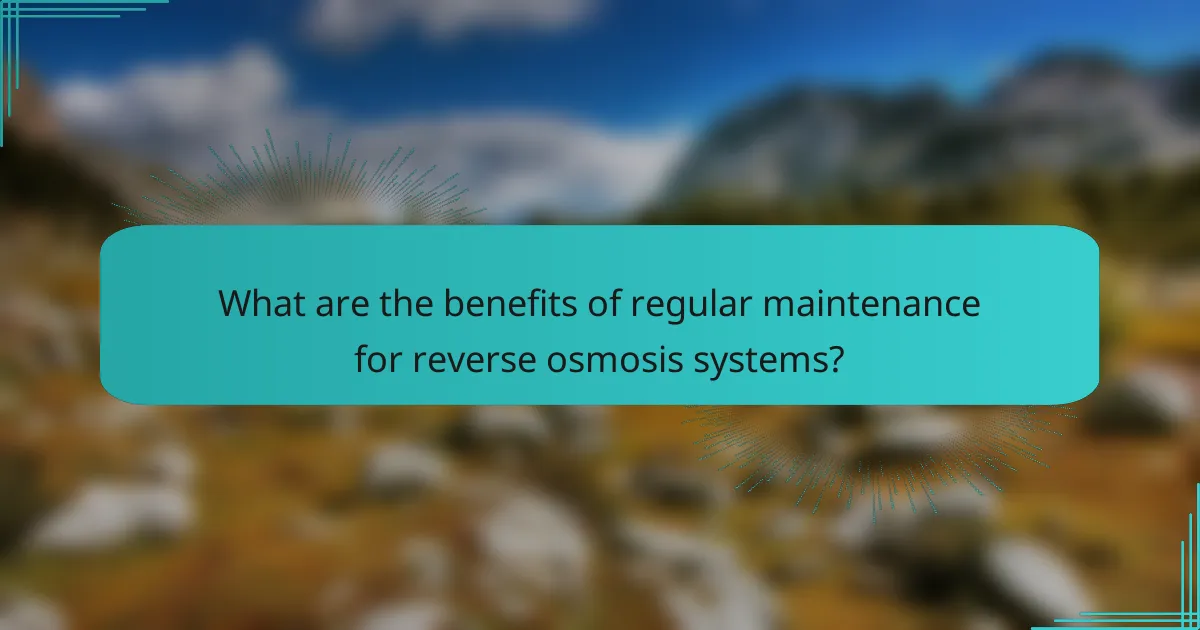
What are the benefits of regular maintenance for reverse osmosis systems?
Regular maintenance of reverse osmosis systems significantly enhances their performance and longevity. By adhering to a maintenance schedule, users can ensure optimal water quality, extend the lifespan of the system, and achieve cost savings over time.
Improved water quality
Regular maintenance, including timely filter changes and system flushing, directly impacts the quality of water produced by reverse osmosis systems. When filters are replaced as needed, contaminants are effectively removed, resulting in cleaner, safer drinking water.
Additionally, periodic flushing helps eliminate any buildup of impurities within the system, ensuring that the water remains fresh and free of unpleasant tastes or odors. This is particularly important in areas where water quality may fluctuate.
Extended system lifespan
Consistent maintenance practices can significantly prolong the lifespan of reverse osmosis systems. By regularly cleaning membranes and replacing worn-out filters, users can prevent damage that may lead to costly repairs or system failures.
For instance, neglecting to clean the membranes can result in scaling and fouling, which diminishes efficiency and may require premature replacement. A well-maintained system can last for many years, providing reliable service.
Cost savings over time
Investing in regular maintenance for reverse osmosis systems can lead to substantial cost savings in the long run. While there may be upfront costs for replacement filters and cleaning supplies, these are often outweighed by the savings from reduced water bills and fewer repair expenses.
Furthermore, maintaining optimal performance can lower energy consumption, as systems that operate efficiently use less power. Users can expect to save tens of percent on operational costs by adhering to a regular maintenance schedule.
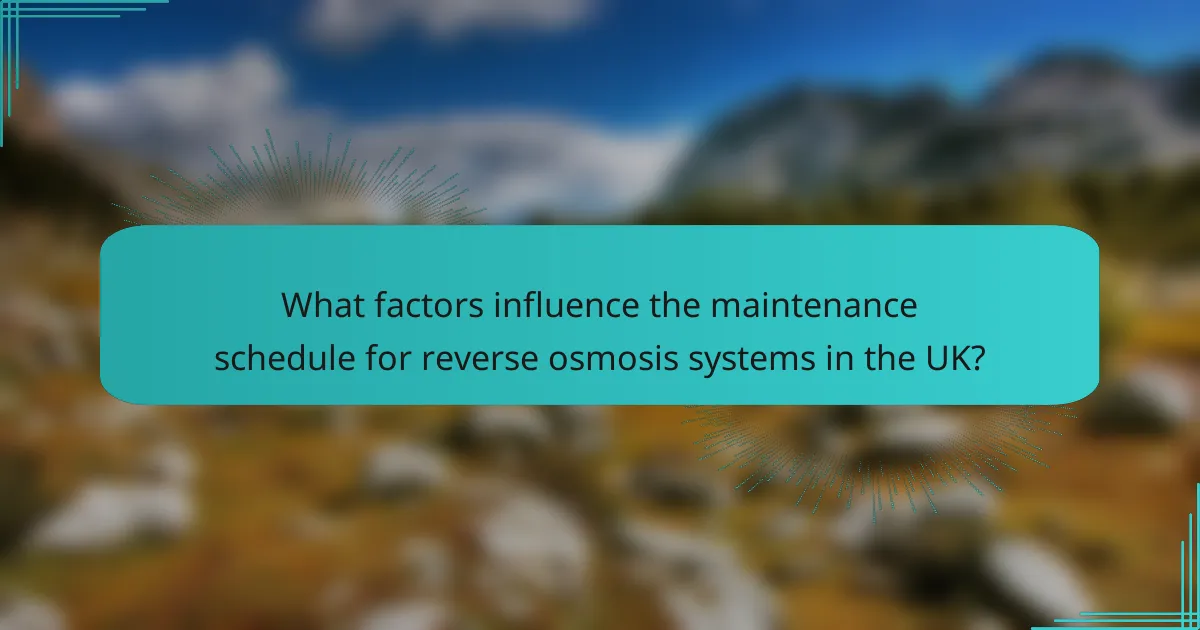
What factors influence the maintenance schedule for reverse osmosis systems in the UK?
The maintenance schedule for reverse osmosis systems in the UK is primarily influenced by local water quality, usage patterns, and the specific system design. Understanding these factors helps ensure optimal performance and longevity of the system.
Local water quality variations
Water quality can vary significantly across different regions in the UK, affecting the frequency of filter changes and system maintenance. Areas with hard water or high levels of contaminants may require more frequent maintenance to prevent scaling and fouling of the membranes.
For example, if your local water supply has elevated levels of chlorine or sediment, you might need to replace pre-filters every 6 to 12 months, while a system in a region with softer water may only need annual changes. Regular testing of water quality can help determine the appropriate maintenance schedule.
Usage patterns
The amount of water consumed daily also plays a crucial role in determining maintenance needs for reverse osmosis systems. Higher usage typically leads to faster depletion of filter life and increased wear on the system components.
If your household uses a significant amount of water for drinking, cooking, or other purposes, consider monitoring the system more closely. A family of four, for instance, may need to flush the system quarterly and replace filters every 6 to 12 months, while a single-person household might extend those intervals.
